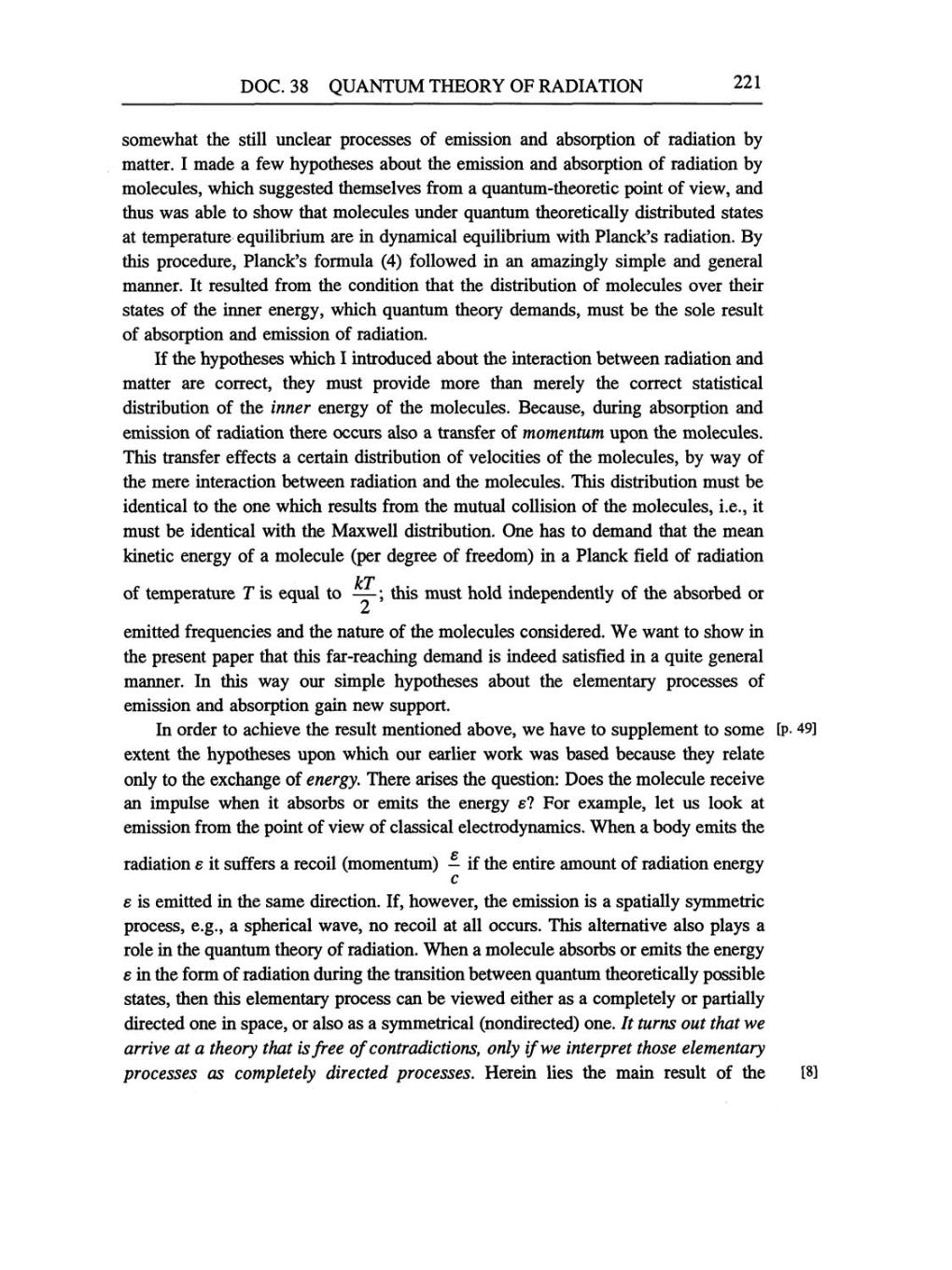DOC.
38
QUANTUM
THEORY OF RADIATION
221
somewhat the still unclear
processes
of
emission and
absorption
of
radiation
by
matter. I
made
a
few
hypotheses
about the emission and
absorption
of
radiation
by
molecules,
which
suggested
themselves from
a
quantum-theoretic point
of
view,
and
thus
was
able
to
show that
molecules under
quantum theoretically
distributed states
at
temperature equilibrium
are
in
dynamical equilibrium
with Planck's radiation.
By
this
procedure,
Planck's formula
(4)
followed in
an
amazingly simple
and
general
manner.
It resulted from the condition that the distribution
of
molecules
over
their
states
of the inner
energy,
which
quantum theory
demands, must
be the sole result
of
absorption
and
emission of radiation.
If
the
hypotheses
which
I
introduced about the interaction between radiation and
matter
are
correct, they
must
provide more
than
merely
the correct
statistical
distribution
of
the inner
energy
of
the molecules.
Because, during absorption
and
emission
of radiation there
occurs
also
a
transfer of
momentum
upon
the molecules.
This transfer
effects
a
certain
distribution
of velocities
of
the
molecules, by way
of
the
mere
interaction between radiation and the molecules. This distribution must be
identical to the
one
which results from the mutual collision of the
molecules, i.e.,
it
must be identical with the Maxwell distribution. One has to demand that the
mean
kinetic
energy
of
a
molecule
(per
degree
of
freedom)
in
a
Planck field of radiation
of
temperature
T is
equal
to
kT-2;
this
must
hold
independently
of the
absorbed
or
emitted
frequencies
and the nature of the molecules considered. We want to show in
the
present paper
that this
far-reaching
demand is indeed satisfied in
a
quite
general
manner.
In this
way our simple hypotheses
about the
elementary processes
of
emission and
absorption gain
new
support.
In order
to
achieve the result mentioned
above,
we
have to
supplement
to
some
[p.
49]
extent the
hypotheses upon
which
our
earlier work
was
based because
they
relate
only
to the
exchange
of
energy.
There arises the
question:
Does the molecule receive
an impulse
when it absorbs
or
emits the
energy
e?
For
example,
let
us
look
at
emission from the
point
of
view
of
classical
electrodynamics.
When
a
body
emits the
radiation
e
it suffers
a
recoil
(momentum)
e/c
if
the entire amount
of
radiation
energy
e
is emitted in the
same
direction.
If, however,
the emission is
a
spatially symmetric
process, e.g.,
a
spherical
wave,
no
recoil at all
occurs.
This alternative also
plays
a
role in
the
quantum theory
of radiation. When
a
molecule absorbs
or
emits the
energy
e
in
the
form
of
radiation
during
the transition between
quantum theoretically
possible
states,
then this
elementary process can
be viewed either
as a
completely
or
partially
directed
one
in
space,
or
also
as
a
symmetrical (nondirected) one.
It
turns out
that
we
arrive
at
a theory
that
is
free
of
contradictions, only
if
we
interpret
those
elementary
processes
as
completely
directed
processes.
Herein lies the main result of the
[8]
